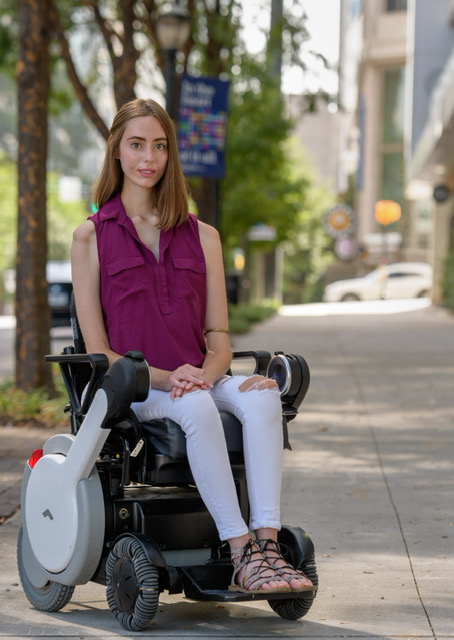
(She/Her) | Atlanta, GA
Transit equity is an issue I work diligently on with many local advocacy organizations in the Atlanta area and MARTA (directly on their writers’ committee). It is essential to me because of my progressive disability. I started using a wheelchair in my early twenties. Traveling long distances got more and more difficult and using stairs became more challenging. My lens shifted from walking and running, to not being able to do that very well, to then not being able to walk at all and using a wheelchair full time.
I graduated college in 2015, moved back to Atlanta, and started riding MARTA a little bit here and there. I also had a car at the time because I still was able to drive then. I soon stopped driving altogether and shifted full time to riding on the sidewalk in my wheelchair and scooter and then riding buses and trains fully to get around the city.
For me, the issue that I see specifically with MARTA is the lack of accessibility. I know the walkability of the city is an Atlanta and surrounding county issue, but that is the core area of being able to get to the stations. It is the first thing that you interact with to get to transit. You take a sidewalk to get to the bus stop. You take a sidewalk to get to the train station. When the sidewalks are non-existent, when they’re crumbled, and when they’re lacking curb ramps for wheelchairs, it becomes an equity issue. Sidewalks and transportation go hand in hand. You can’t have one without the other.
Being able to get onto the train is one thing, but what I see a lot with MARTA is the elevators are out a lot. It’s definitely an equity issue. What I’ve seen is the real-time alerts are not focused on the status of the elevators. I know they’re focusing on redoing all the elevators and escalators and making their system better for real-time alerts, but I’m often the one recording the outages. That’s problematic because, first off, the transit operator has no idea that the elevators are out of service. It’s not in the app or the website. There’s no overhead announcement when you get off the train. So, I’m thinking that I’m going to be okay, because I haven’t seen any notification, but I get off and the one elevator to get up to street level is broken. With MARTA, and especially during COVID, our headways are very long, sometimes they’re 24 minutes. That is annoying because now I have to wait on the platform and sometimes the platform is not the right one I have to be on. It’ll be southbound or westbound, and I’m going north. They’re not on the same side. I would’ve had to take an elevator to cross over to go back down. I’m stuck essentially. I have to wait 24 minutes to get back on a train, go to another stop–hoping that the elevator there is working, get off, cross the platform to the other side, wait another 20 minutes, and then backtrack to my initial stop. Sometimes it’s 45 minutes to an hour until I can get to my destination. That is not time I factored into where I was going. What that impact is on me is I’m missing appointments, I’m late to things, or if I’m late it’s just a general inconvenience for me. So, it’s really problematic when the elevators are out.
On top of that, when you need to report the elevator outages, you’re supposed to have the police phone numbers and use the white telephones to call the police on the platform. Sometimes even those telephones are out of service. Not only can I not report it with the telephone that is supposed to be operational, that means that someone else behind me will experience the same issue. Even the cleaning staff heavily uses the elevators to be able to clean the platform. They now can’t do their job. It’s more than just a wheelchair perspective, it’s impacting the employees of MARTA. They can’t clean because they can’t take their cart down the stairs. It is impacting a lot of other people that have chronic illnesses and invisible disabilities and need elevators and can’t use escalators or stairs. It is impacting people with bicycles, strollers, luggage, anything else where someone would need to use an elevator and they can’t.
There are other inequities on the train station I’ve noticed, and one specific issue is with high contrast warning colors and overhead announcements. Several stations worldwide have tactile warning strips at the edge of the platform, like a sidewalk or crosswalk’s curb cut that has a yellow or red plate with little bumps on it. They are supposed to be a high contrast color. In Atlanta, what we have on a lot of our platforms are gray tactile warning strips. So you have a gray concrete platform with a gray tactile warning and that is problematic for individuals who have low vision and, other than the feeling of the bump element, they cannot visually differentiate the color between the warning plate and the concrete of the platform at the platform’s edge. That’s a safety issue so they need to be high contrast with whatever the color of the platform is.
I have to think, yes, I do use a wheelchair and that’s the lens that I primarily look through, but I’m also thinking about other disabilities. The different ways MARTA conveys information or services they provide also need to be accessible.
